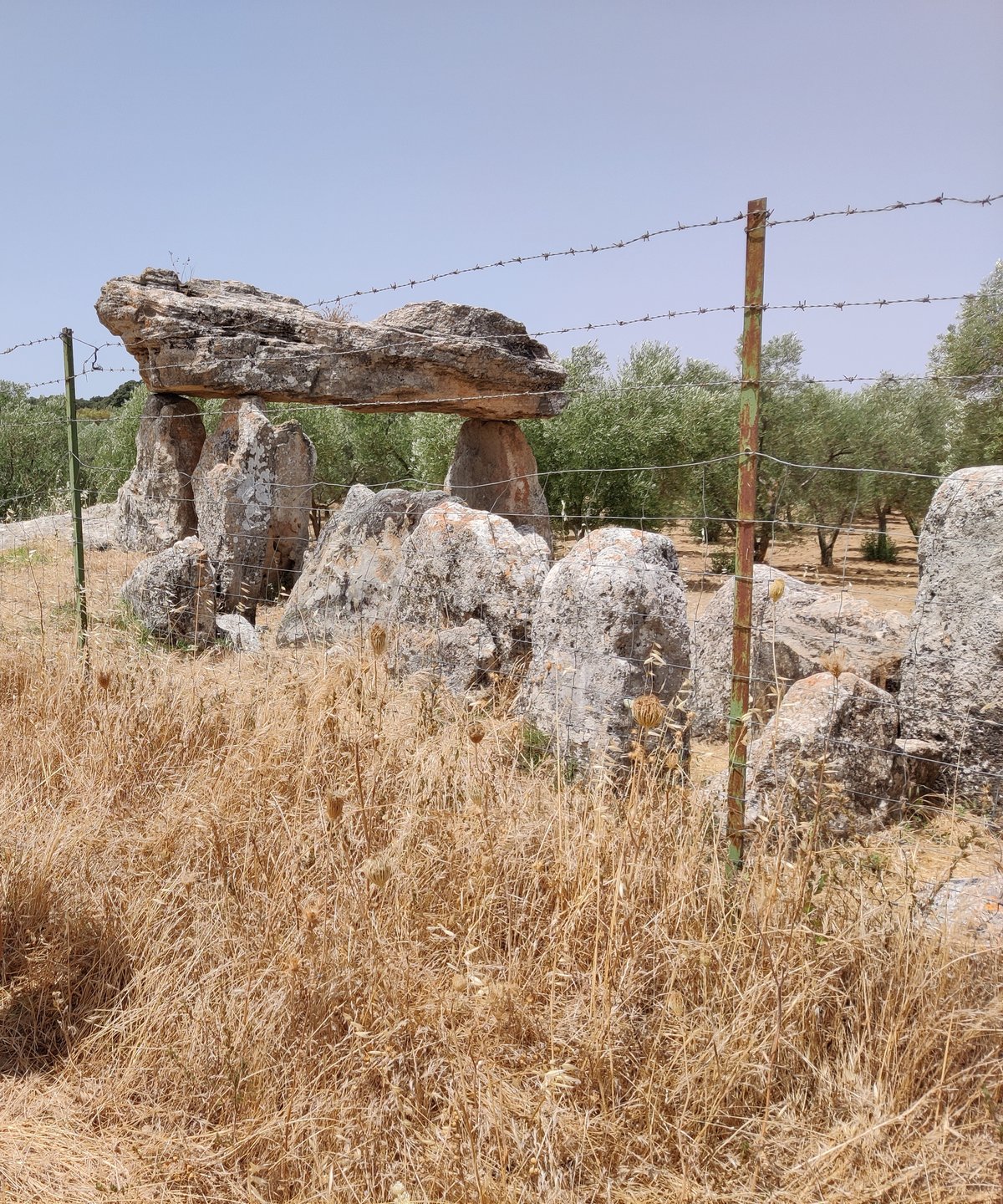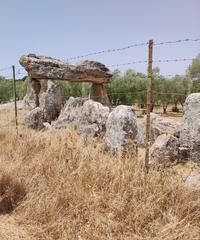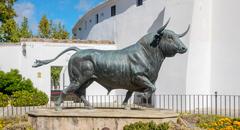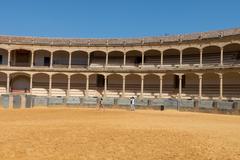
Dolmen de la Giganta: Visiting Hours, Tickets, and Ronda Historical Sites Guide
Date: 14/06/2025
Introduction
Nestled in the rolling landscapes of the Serranía de Ronda near the historic town of Ronda, Spain, the Dolmen de la Giganta (also known as Dolmen del Chopo) stands as one of Andalusia’s most evocative prehistoric monuments. Dating to the late Neolithic or early Chalcolithic period (circa 3000–2000 BCE), this megalithic tomb offers a unique window into the funerary rituals, social organization, and spiritual beliefs of Iberia’s earliest settled communities. Its construction from massive local limestone slabs, forming a corridor leading to a burial chamber, showcases the ingenuity and ritual significance attributed to collective burial sites in southern Spain (Málaga.es, Grazalema Guide).
Today, Dolmen de la Giganta is accessible year-round during daylight hours, with no formal visitor infrastructure or ticketing. Its tranquil rural setting, panoramic vistas, and proximity to Ronda—famous for its dramatic gorge and rich cultural heritage—make it an excellent choice for visitors interested in archaeology, history, and Andalusia’s scenic beauty. This guide equips travelers with practical information on visiting hours, access, transportation, and site etiquette, alongside deep historical, cultural, and archaeological context. Whether you’re a history enthusiast, a lover of ancient mysteries, or an adventurous traveler, Dolmen de la Giganta offers a memorable connection to Spain’s prehistoric past (The Viva La Vita, Ronda Tours, Wikiloc Hiking Route).
Quick Reference: Contents
- Introduction
- Visitor Information
- Visiting Hours and Entry
- Location, Access, and Transportation
- Accessibility
- Nearby Attractions
- Historical and Archaeological Overview
- Prehistoric Context and Megalithic Culture
- Architectural Features
- Funerary and Ritual Significance
- Cultural and Regional Importance
- Preservation and Research
- Conservation Status
- Archaeological Research and Interpretation
- Visitor Experience
- Practical Tips
- Guided Tours
- Atmosphere and Photography
- Family and Group Visits
- Safety and Preservation
- Special Events and Community Engagement
- Frequently Asked Questions (FAQ)
- Conclusion and Further Resources
Visitor Information
Visiting Hours and Entry
Dolmen de la Giganta is an open-air archaeological site with free, year-round access. There are no formal opening or closing hours, but visits are recommended during daylight—typically from 9:00 AM to 6:00 PM. There is no entrance fee or ticketing system, and the site is unstaffed.
Location, Access, and Transportation
Located near the village of Montecorto, approximately 10 kilometers from Ronda, the dolmen is best reached by car. The route includes rural roads and a short walk along an uneven path, crossing farmland—visitors should respect local property and follow marked trails. GPS navigation and hiking routes are available (Wikiloc Hiking Route). Public transport does not reach the dolmen directly, but Ronda is served by bus and train from Málaga and Seville, and local taxis or guided tour operators can provide connections (The Viva La Vita, Ronda Tours).
Accessibility
The approach to Dolmen de la Giganta involves unpaved, sometimes uneven terrain. The site is not wheelchair accessible and may be challenging for visitors with limited mobility. There are no on-site facilities such as restrooms or visitor centers.
Nearby Attractions
Combine your visit with:
- Ronda’s historic old town and the iconic Puente Nuevo bridge
- Sierra de Grazalema Natural Park
- Other megalithic monuments such as the Dolmen de Menga in Antequera
- The white villages of Montecorto and Benaoján (Mapcarta)
Historical and Archaeological Overview
Prehistoric Context and Megalithic Culture
The Dolmen de la Giganta is part of a broad tradition of megalithic tomb building in southern Iberia, reflecting complex social structures and ritual practices of Neolithic and Chalcolithic communities (Málaga.es). The monument’s construction, involving large limestone orthostats and capstones, demonstrates impressive communal effort and technical skill in an age before metal tools.
Architectural Features
The dolmen consists of a trapezoidal corridor leading to a burial chamber, originally covered by an earthen mound (now eroded). The structure measures approximately 8.5 meters in length, with orthostats up to 2.2 meters high. Though partially collapsed, several of the original stones and one shifted capstone remain visible (Grazalema Guide).
Funerary and Ritual Significance
Intended for collective burials over generations, dolmens like La Giganta served as focal points for ancestor veneration and communal gatherings. Archaeological parallels from the region include grave goods such as pottery and flint tools, attesting to a belief in the afterlife and the symbolic role of these monuments in community identity (Grazalema Guide).
Cultural and Regional Importance
The dolmen’s location on a plateau with commanding views links it to territorial and possibly astronomical functions. Local folklore, including tales of a giantess who built the monument, adds layers of myth and tradition, situating the site within Andalusia’s rich cultural tapestry (Ronda Tours, Mapcarta).
Preservation and Research
Conservation Status
Dolmen de la Giganta is relatively well-preserved, though exposed to natural erosion and encroaching vegetation. The site’s position on private land and partial fencing limit direct access, contributing both to its preservation and to visitor restrictions (Wikiloc Hiking Route).
Archaeological Research and Interpretation
While the monument has not been the subject of systematic modern excavation, it remains a valuable source for future archaeological study, with potential to reveal further details about prehistoric lifeways, social hierarchies, and ritual behaviors (Málaga.es).
Visitor Experience
Practical Tips
- Best Time to Visit: Spring (March–May) and autumn (September–November) offer the best climate and light for photography; summer can be very hot (The Viva La Vita).
- What to Bring: Sturdy walking shoes, water, sun protection, camera, and any food or supplies (no shops on site).
- Respect the Site: Do not climb on or touch the stones; take all litter with you.
- Combine Visits: Consider pairing the dolmen with Ronda’s historic attractions and natural parks for a richer experience.
Guided Tours
While there are no official guided tours at the site itself, several local operators in Ronda include the dolmen in their itineraries. These tours often provide archaeological background, local legends, and transport arrangements (Ronda Tours).
Atmosphere and Photography
The rural tranquility of the dolmen’s surroundings makes it ideal for quiet contemplation and photography. Early morning and late afternoon provide the most dramatic light and minimal crowds.
Family and Group Visits
The site is suitable for families and school groups, with young children requiring supervision due to uneven terrain. Educational tours occasionally use the dolmen as an outdoor classroom.
Safety and Preservation
As an unstaffed site, visitors are responsible for their own safety. Stones can be slippery when wet. Mindful behavior is essential to protect this irreplaceable heritage.
Special Events and Community Engagement
Seasonal events, particularly around the summer solstice, are sometimes held at or near the dolmen, celebrating its ancient ritual role. Local organizations encourage respectful engagement, and visitors may see offerings such as flowers or stones left in homage to the site’s spiritual past. Preservation efforts involve educational outreach and partnerships between heritage authorities and tour operators (Ronda Tours).
Frequently Asked Questions (FAQ)
Q: What are the Dolmen de la Giganta visiting hours?
A: The site is open year-round during daylight hours (generally 9:00 AM–6:00 PM); direct access may be limited by private property boundaries.
Q: Is there an entrance fee or ticket required?
A: No, the site is free to visit and unstaffed.
Q: Is the dolmen accessible for people with disabilities?
A: The path is uneven and unpaved; wheelchair access is not available.
Q: Can I join a guided tour?
A: Yes, local tour operators include the dolmen in some itineraries; inquire at Ronda’s tourist office or online (Ronda Tours).
Q: What is the best time of year to visit?
A: Spring and autumn, for pleasant weather and fewer visitors.
Q: Are there facilities at the site?
A: No, there are no restrooms, shops, or shelter. Prepare accordingly.
Conclusion
Dolmen de la Giganta is a silent testament to the ingenuity and spiritual depth of Andalusia’s prehistoric societies. Despite its modest infrastructure and the limitations posed by private land ownership, the site’s evocative setting and cultural resonance make it a rewarding destination for those seeking history, landscape, and legend. By visiting with care and curiosity—and by exploring nearby Ronda and other megalithic monuments—you can immerse yourself in the rich, layered heritage of southern Spain.
Stay updated and enhance your experience by consulting the Audiala app for interactive maps, travel tips, and guides to Andalusian heritage sites.
Further Resources
- Spain.info - Ronda
- Dolmen de la Giganta (Málaga.es)
- The Viva La Vita - Tips for Visiting Ronda
- Ronda Tours
- Grazalema Guide: Dolmen La Giganta
- Wikiloc Hiking Route: Dolmen de la Giganta
- Mapcarta - Dolmen de la Giganta
Visuals and Media
- Image 1: Dolmen de la Giganta entrance — Alt text: “Dolmen de la Giganta megalithic tomb near Ronda, Spain”
- Image 2: Panoramic view from the dolmen’s plateau — Alt text: “Panoramic valley view from Dolmen de la Giganta site, Andalusia”
- Map: Location and suggested routes to the dolmen
- Virtual Tour: [Check local tourism websites for digital tours]
For more on Ronda’s historical treasures and Andalusia’s ancient wonders, browse our related articles or connect with us on social media. Download the Audiala app for interactive maps and up-to-date heritage site information.
Sources
- Dolmen de La Giganta Visiting Hours, Tickets, and Historical Guide in Málaga, 2025 (Spain.info - Ronda)
- Dolmen de la Giganta: Visiting Guide and Archaeological Significance of Ronda’s Megalithic Wonder, 2025 (Málaga.es)
- Visiting Dolmen De La Giganta: Hours, Tickets, and Exploring Ronda’s Ancient Megalithic Tomb, 2025 (The Viva La Vita)
- Guide to Visiting the Dolmen De La Giganta and Exploring Ronda Historical Sites, 2025 (Ronda Tours)
- Grazalema Guide: Dolmen La Giganta, 2025 (Grazalema Guide)
- Wikiloc Hiking Route: Ronda Dolmen de la Giganta, 2025 (Wikiloc Hiking Route)
- Mapcarta - Dolmen de La Giganta, 2025 (Mapcarta)



